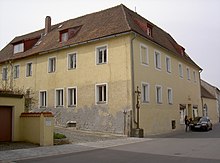Capuchin monastery Vohenstrauss
The abandoned Capuchin monastery Vohenstrauß was located in the Upper Palatinate town of Vohenstrauss . In the course of secularization , the monastery was dissolved in 1802 and the monastery building (Pfarrgasse 9) moved into in 1763 was used as the “old rectory”.
history
The monastery was founded in the course of the Counter-Reformation by Count Palatine Christian August , who converted to Catholic teaching in 1656. Since there were too few secular priests in his duchy of Neuburg-Sulzbach , two Capuchin Fathers from the Capuchin Monastery in Neumarkt in Upper Palatinate and a lay brother were sent to Vohenstrauss on February 22nd, 1657, accompanied by Government Commissioner Wolfgang Schweitzer. The order of the Count Palatine was read to the citizens by the nurse Gravenreuth to treat the Fathers with due respect. The first Catholic parish administrator was Johann Meuerl, who should take care of secular affairs.
Under Maximilian I and the beginning of the Counter Reformation , the area was increasingly "made Catholic" again. Due to their friendly nature, the Capuchins were able to win over the people in the Vohenstrauss area ( Altenstadt , Oberlind , Woppenrieth, Waldau from 1657, Kaimling ). In 1710 a third Father came to Vohenstrauss. The Waldau squire Johann Karl Freiherr von Rummel donated a benefit for Waldau in 1716 .
An incident is reported which worsened the relationship between the Catholics and the Lutherans in Vohenstrauss: An evangelical master linen weaver had committed various thefts and was therefore excluded from the guild . In 1774 he was caught while stealing fruit again and went to prison. The Capuchins now offered him that he would go unpunished if he converted to the Catholic faith, which he did. The problem was that now his five children should also become Catholics, which the Protestant pastor Philipp Kaspar Fuchs resisted. Indeed, the two older brothers were saved from conversion. A daughter fled to her godfather. There was a big crowd in which the rushing Catholic judge Rosner was beaten. Since the perpetrators could not be found, the entire evangelical community was punished, Pastor Fuchs was removed from his post and Johann Georg Fembo was installed in his place. Only the sacristan and one other person were present at his inaugural sermon. The three younger children of the delinquent were "made Catholic".
During the great fire in Vohenstrauss on June 9th, 1763 the Capuchins were able to save some vestments, pictures and a baby Jesus from Prague . Around 1710, a public St. Joseph chapel was founded in the Kapuziner hospice (Pfarrgasse 9). The hospice building was occupied by the Capuchins after the great city fire of 1763, before they had their accommodation in a building at Wittschauer Strasse 14.
The decision to secularize the Bavarian Capuchin monasteries was made in February 1802. In April, the confreres of the abolished branches of Parkstein and Weiden in the Upper Palatinate arrived in Burglengenfeld , followed in August by the monastery inmates from Sulzbach and Vohenstrauss. After it had looked for some time as if Burglengenfeld should remain as the central monastery, on December 27th 1802 the abolition took place here too. Most of the former conventuals came to Altötting in the now vacated Capuchin monastery Altötting . The last provisional parish priest in Vohenstrauß was Father Erhard Müller from Schmidmühlen . After the monks had left, the parish was looked after by world priests, the first was Pastor Franz Kellermann, who arrived in Vohenstrauss on August 26, 1802 and moved into the Capuchin hospice as a parsonage.
building
The Capuchin monastery, which was moved into in 1763, became a Catholic parsonage after secularization. Today it is still a two- wing hipped roof building with stone walls and a stone portal. A cast iron crucifix from around 1900 is attached to the outside .
literature
- City of Vohenstrauß (Ed.): Vohenstrauss in the course of time: local history on the history of the city on the occasion of the 600th anniversary of its first mention 1378 - 1978. Vohenstrauß 1978, p. 117ff.
Web links
Individual evidence
- ↑ The Capuchin Monastery Burglengenfeld - Pastoral Care in the Country. House of Bavarian History - Monasteries In Bavaria
Coordinates: 49 ° 37 ′ 21.9 ″ N , 12 ° 20 ′ 25.5 ″ E


